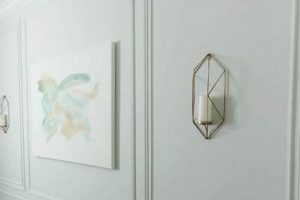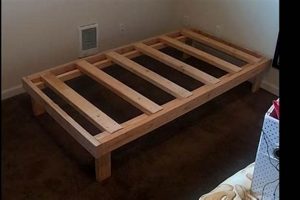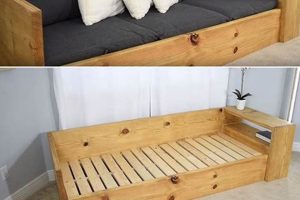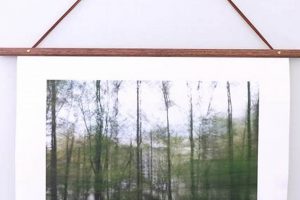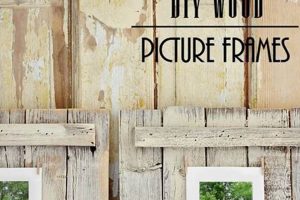The phrase refers to the process of constructing a border or structure intended to support a projection surface for viewing films or other visual media. This construction is typically undertaken by individuals rather than purchased as a pre-assembled product. An example includes building a wooden rectangle covered in black velvet to enhance contrast when projecting an image onto a white screen stretched within the frame.
Creating one’s own support structure for a projection screen offers numerous advantages, including cost savings, customization options, and the ability to adapt the screen size and aspect ratio to specific needs and spaces. Historically, individuals have crafted viewing setups to circumvent the expense and limitations of commercially available products, often resulting in tailored solutions optimized for their viewing environments. This approach empowers individuals to control the aesthetic and functional characteristics of their home cinema experience.
The following sections will explore materials suitable for these constructions, methods for assembling a robust and aesthetically pleasing border, and techniques for achieving optimal screen tension and alignment.
Assembling a Quality Viewing Border
The construction of a suitable viewing border requires careful consideration of materials, design, and execution. The following guidelines aim to provide a framework for achieving a professional-grade result.
Tip 1: Material Selection: Prioritize dimensionally stable materials such as kiln-dried hardwood or aluminum extrusions. These options resist warping and ensure long-term structural integrity. Softwoods, while less expensive, are prone to distortion over time, potentially affecting screen flatness.
Tip 2: Frame Design: Employ a mitered corner design for a clean, professional aesthetic. Precise cuts, typically at 45-degree angles, are essential. Reinforce mitered joints with glue, screws, or corner braces for added strength.
Tip 3: Surface Treatment: Apply a light-absorbing finish to the structure. Black velvet or matte black paint minimize light reflection and maximize perceived contrast from the projected image. Ensure complete coverage, paying close attention to edges and corners.
Tip 4: Screen Mounting: Implement a robust screen attachment method. Options include stapling, using fabric clips, or employing a tensioning system. Even tension distribution across the screen surface is critical to eliminate wrinkles and distortion.
Tip 5: Screen Material Choice: Select a screen material appropriate for the intended projection environment. Matte white screens are suitable for dark rooms, while grey screens enhance contrast in environments with ambient light. Consider gain values to optimize brightness based on projector specifications and viewing distance.
Tip 6: Precise Measurement and Alignment: Prior to cutting materials, meticulously measure the intended screen dimensions. Ensure the structure is perfectly square and level during assembly. Even slight misalignments can result in geometric distortion and diminished viewing quality.
Tip 7: Consider a Backing Board: For enhanced rigidity and ease of mounting, consider attaching the structure to a thin backing board, such as MDF or plywood. This also simplifies wall mounting.
Adhering to these tips will contribute to the creation of a durable, visually appealing, and functionally effective viewing border. The resulting structure will significantly enhance the overall viewing experience by providing a stable and aesthetically pleasing platform for the projected image.
The subsequent sections will delve into specific techniques for achieving optimal screen tension and addressing common construction challenges.
1. Material Durability
Material durability directly impacts the lifespan and performance of a self-constructed viewing border. The selection of materials with inherent resistance to warping, cracking, or degradation is paramount to ensuring long-term structural integrity. For example, using kiln-dried hardwood, like poplar or maple, inherently reduces the risk of frame distortion compared to less stable alternatives such as untreated pine. This choice mitigates potential issues like uneven screen tension, which can manifest as visible wrinkles or geometric distortions in the projected image. The causative relationship is clear: inadequate material durability leads to compromised screen quality and diminished viewing experience.
The practical significance of material durability extends beyond initial assembly. A robust structure made from durable components is less susceptible to environmental factors, such as fluctuations in temperature and humidity, which can exacerbate material weaknesses. Consider the scenario where an individual constructs a border using inexpensive particleboard. Over time, moisture absorption can cause swelling and deformation, ultimately rendering the structure unusable. Conversely, a frame constructed from aluminum extrusions, known for their resistance to corrosion and dimensional stability, will maintain its structural integrity for an extended period, justifying the higher initial investment. This illustrates the trade-off between initial cost and long-term value, underscoring the importance of informed material selection.
In conclusion, material durability represents a critical consideration in any construction endeavor involving projection screens. The initial selection directly influences the structure’s longevity, resistance to environmental factors, and ability to maintain optimal screen tension. By prioritizing materials with demonstrated durability, individuals can minimize the risk of premature failure, ensuring a consistently high-quality viewing experience over an extended lifespan. Challenges in this area often stem from balancing budget constraints with long-term performance requirements, necessitating a thorough understanding of material properties and their impact on the overall system.
2. Structural Integrity
Structural integrity is a paramount consideration in the context of constructing a projection support system. The ability of the structure to withstand forces, maintain its shape, and resist deformation directly impacts the quality of the projected image and the lifespan of the entire assembly. Deficiencies in structural integrity can manifest as sagging, warping, or outright failure, leading to distorted images and a compromised viewing experience.
- Joint Stability
The strength and rigidity of the connections between individual components are critical. Weak joints can lead to movement and misalignment over time. Examples include using insufficient glue or fasteners in mitered corners. Proper joint construction involves employing techniques such as mortise and tenon, biscuit joints, or reinforced miter joints with metal brackets. These methods distribute stress more effectively and prevent premature failure.
- Material Rigidity
The inherent stiffness of the chosen material contributes significantly to overall structural integrity. Materials with high flexural modulus, such as hardwood or aluminum, are less prone to bending under load compared to softer materials like softwood or plastic. A frame constructed from a rigid material will maintain a flatter, more stable surface for the screen material, resulting in a sharper, more accurate image.
- Load Distribution
The design of the support system must effectively distribute the weight of the screen material and any applied tension. Uneven load distribution can create stress points and lead to deformation. Incorporating cross braces or a backing board can help distribute the load more evenly across the entire structure. This is particularly important for larger screens where the weight and tension forces are greater.
- Environmental Resistance
Exposure to varying environmental conditions, such as temperature and humidity fluctuations, can negatively impact structural integrity. Materials that are susceptible to moisture absorption or expansion and contraction can warp or weaken over time. Using materials with inherent resistance to environmental degradation or applying protective coatings can mitigate these risks. For example, sealing a wooden frame with a moisture-resistant finish can prevent warping and prolong its lifespan.
These facets of structural integrity are interconnected and collectively determine the overall performance of a self-made screen support structure. By carefully considering each of these aspects during the design and construction phases, individuals can create a durable and reliable system that provides a high-quality viewing experience for years to come. Overlooking these details can result in a compromised structure that detracts from the intended visual experience.
3. Fabric Tension
Fabric tension represents a critical determinant of image quality in self-constructed viewing setups. The degree to which the screen material is stretched taut across the support structure directly influences the geometric accuracy and overall clarity of the projected image. Insufficient tension results in wrinkles, sags, or puckers on the screen surface, introducing distortions that detract from the viewing experience. Conversely, excessive tension can overstress the material, potentially leading to tearing or detachment from the frame. The objective, therefore, is to achieve optimal tension, striking a balance that minimizes distortion while preserving the integrity of the screen material. This balance necessitates careful consideration of material properties, attachment methods, and frame design.
Achieving proper fabric tension often involves employing specific techniques during the assembly process. Examples include using spring-loaded tensioning systems, carefully stapling the material to the frame in a uniform pattern, or utilizing fabric clips designed to distribute tension evenly. The type of material further influences the optimal tension level; thicker, more rigid materials may require greater tension to achieve a flat surface, while thinner, more flexible materials are more susceptible to damage from over-stretching. The frame design also plays a critical role. A robust, dimensionally stable frame is essential to withstand the forces exerted by the tensioned fabric. For instance, a frame constructed from thin, flexible wood may bow or warp under tension, compromising the flatness of the screen surface. Therefore, the choice of materials and construction methods must be carefully aligned to ensure the frame can adequately support the tensioned fabric.
In summary, fabric tension stands as a key factor in maximizing the performance of do-it-yourself projection screens. Achieving optimal tension requires a thorough understanding of material properties, careful assembly techniques, and a structurally sound frame design. The challenges inherent in achieving and maintaining proper tension often necessitate experimentation and fine-tuning to achieve the desired image quality. By prioritizing fabric tension as a design element, individuals can significantly enhance their viewing experience and realize the full potential of their self-constructed screen.
4. Light Absorption
Effective image projection necessitates careful management of ambient and reflected light. In the context of a self-constructed viewing border, strategic light absorption is crucial for maximizing perceived contrast and minimizing distractions, thereby enhancing the overall viewing experience. The properties of the materials used in the borders construction directly influence the degree to which unwanted light is absorbed or reflected.
- Material Selection for Light Absorption
The choice of materials for the structure significantly affects its light-absorbing capabilities. Surfaces with a matte finish and dark color, such as black velvet or specific dark-colored paints, are highly effective at absorbing incident light. Conversely, glossy surfaces or light colors tend to reflect light, potentially washing out the projected image and reducing contrast. The selection of appropriate materials is a primary step in controlling light reflection within the viewing environment.
- Surface Treatment Techniques
Applying specific treatments to the border’s surface can enhance light absorption. For instance, flocking, a process that involves adhering short fibers to a surface, creates a highly absorbent, non-reflective finish. Similarly, applying multiple coats of matte black paint can further reduce light reflection. These techniques effectively minimize stray light, contributing to a clearer, more vibrant projected image. The effectiveness of these treatments depends on the uniformity and density of the applied coating.
- Impact on Perceived Contrast
The level of light absorption directly correlates with the perceived contrast of the projected image. A border that effectively absorbs stray light allows the viewer to perceive a greater difference between the brightest and darkest parts of the image. This enhances image detail and clarity, resulting in a more immersive viewing experience. In contrast, a highly reflective border can reduce perceived contrast, making the image appear washed out and less defined.
- Integration with Room Lighting Conditions
The effectiveness of light absorption is influenced by the overall lighting conditions within the room. In environments with significant ambient light, even a highly absorbent border may not completely eliminate unwanted reflections. Therefore, it is crucial to consider room lighting conditions when selecting materials and applying surface treatments. Implementing blackout curtains or dimming lights can further enhance the impact of light-absorbing surfaces.
The strategic application of light absorption principles in the design and construction of a viewing border represents a cost-effective method for optimizing image quality. By carefully selecting materials, applying appropriate surface treatments, and considering the overall lighting environment, individuals can significantly improve the viewing experience, realizing the full potential of their projection system. Overlooking these details may result in a diminished visual experience, regardless of the quality of the projector or screen material.
5. Dimensional Accuracy
Dimensional accuracy is a foundational element in the successful construction of a viewing structure. Its importance stems from the direct correlation between precise measurements and the resulting image quality. Any deviation from accurate dimensions during construction manifests as geometric distortions in the projected image, directly impacting the viewing experience. The principle is straightforward: precise dimensions result in an accurate and undistorted image; inaccuracies lead to a flawed visual presentation.
Consider a scenario where the constructed rectangle intended to house the projection screen is not perfectly square. Even a minor discrepancy in the corner angles will translate into a keystone effect, where the projected image appears trapezoidal rather than rectangular. Correcting this distortion through projector settings often compromises image sharpness or resolution. Similarly, if the sides of the structure are not of equal length, the projected image may appear stretched or compressed, altering the aspect ratio and distorting the intended visual composition. Real-world examples frequently demonstrate that a difference as small as a quarter of an inch in the dimensions of a large projection support can result in noticeable image distortion.
In conclusion, dimensional accuracy is not merely a desirable attribute but a critical requirement for high-quality image projection. Achieving precise dimensions necessitates the use of accurate measuring tools, meticulous cutting techniques, and a thorough understanding of geometric principles. The challenges inherent in achieving dimensional accuracy often require patience and attention to detail, but the resulting improvement in image quality justifies the effort. Understanding the practical significance of dimensional accuracy enables constructors to mitigate potential distortions and create a viewing structure that optimally supports the projected image, aligning closely with the broader goal of enhancing the home theater environment.
6. Aesthetic Integration
In the context of constructing a viewing structure, aesthetic integration refers to the seamless blending of the system with its surrounding environment. The goal is to create a cohesive visual experience where the structure complements the existing decor, rather than appearing as an intrusive or discordant element. Achieving effective aesthetic integration requires careful consideration of design, materials, and finishing techniques.
- Color Palette Harmonization
The color of the frame should harmonize with the existing color scheme of the room. Neutral tones, such as blacks, grays, or whites, often provide a versatile solution that complements a wide range of decors. However, incorporating accent colors that echo existing design elements can create a more integrated and intentional aesthetic. For example, in a room with dark wood accents, a dark wood stain on the frame could create a cohesive visual link.
- Material Consistency
The materials used in the frame construction should align with the existing materials present in the room. Using similar wood types, metal finishes, or fabric textures can create a sense of continuity and visual harmony. Conversely, introducing disparate materials can create a jarring effect, disrupting the overall aesthetic flow. For instance, constructing a frame from sleek metal in a room dominated by rustic wood furniture may appear out of place.
- Architectural Style Compatibility
The design of the frame should be compatible with the architectural style of the room. A minimalist frame with clean lines may be well-suited to a modern interior, while a more ornate frame with decorative molding may be more appropriate for a traditional setting. Considering the architectural context ensures that the structure contributes to, rather than detracts from, the overall aesthetic coherence of the space.
- Concealment Strategies
In some cases, the most effective approach to aesthetic integration involves concealing the screen when not in use. This can be achieved through retractable screen mechanisms, custom-built cabinetry, or other strategies that allow the screen to seamlessly blend into the surrounding environment. The goal is to minimize the visual impact of the screen when it is not actively in use, preserving the aesthetic integrity of the room.
These interconnected considerations underscore the importance of thoughtful design in constructing a viewing structure. Aesthetic integration extends beyond mere visual appeal; it encompasses the creation of a cohesive and harmonious environment that enhances the overall viewing experience. Failure to adequately address aesthetic considerations can result in a visually disruptive structure that detracts from the intended immersive experience, highlighting the significance of integrating form and function.
Frequently Asked Questions
The following addresses commonly encountered inquiries concerning the creation of a self-made projection screen frame. These answers are intended to provide clarity and guidance for optimal construction.
Question 1: What is the recommended material for a projection viewing structure?
Kiln-dried hardwood, such as poplar or maple, represents a suitable choice due to its dimensional stability and resistance to warping. Aluminum extrusions also provide a durable and rigid alternative. Softwoods, while less expensive, are prone to deformation over time and are generally not recommended.
Question 2: How should corners be joined for optimal structural integrity?
Mitered corners, cut at precise 45-degree angles, offer a clean and professional aesthetic. These joints should be reinforced with glue, screws, or corner braces to ensure long-term stability and prevent separation under tension.
Question 3: What type of finish is best for minimizing light reflection?
A matte black finish or black velvet is highly effective at absorbing stray light and maximizing perceived contrast. The finish should be applied uniformly to all surfaces of the structure, including edges and corners.
Question 4: What methods can be used to attach the screen material to the frame?
Options include stapling, using fabric clips, or employing a tensioning system. Regardless of the method, even tension distribution across the screen surface is crucial to prevent wrinkles and distortions. Spring-loaded tensioning systems offer adjustable tension control.
Question 5: How can dimensional accuracy be ensured during construction?
Precise measurement using accurate measuring tools is essential. Double-check all measurements before cutting materials. Verify that the structure is square and level during assembly to prevent geometric distortions in the projected image. Utilize a carpenter’s square to ensure accurate corner angles.
Question 6: How can the structure be integrated aesthetically with the viewing room?
Consider the existing color scheme and materials in the room. Neutral tones, such as black or gray, are generally versatile. Matching the material or finish of the frame to other elements in the room can create a cohesive look. Concealing the screen when not in use is another strategy for aesthetic integration.
Careful attention to these details will contribute to a successful construction, resulting in an enhanced viewing experience and a visually appealing addition to the home theater environment.
The following sections will further explore advanced techniques for optimizing viewing conditions and addressing specific construction challenges.
Concluding Remarks on Self-Constructed Viewing Borders
This exploration has underscored the multifaceted nature of building a viewing frame. Key considerations, including material selection, structural integrity, fabric tension, light absorption, dimensional accuracy, and aesthetic integration, collectively determine the performance and longevity of the resulting system. Careful attention to each of these aspects is essential for maximizing image quality and ensuring a satisfactory viewing experience.
The enduring significance of this undertaking lies in the ability to tailor a viewing environment precisely to individual needs and preferences. Continued refinement of construction techniques and exploration of innovative materials will undoubtedly lead to further advancements in the pursuit of optimal image projection within a self-constructed framework. Prospective builders are encouraged to approach the endeavor with diligence and a commitment to precision, ultimately transforming the viewing space.


